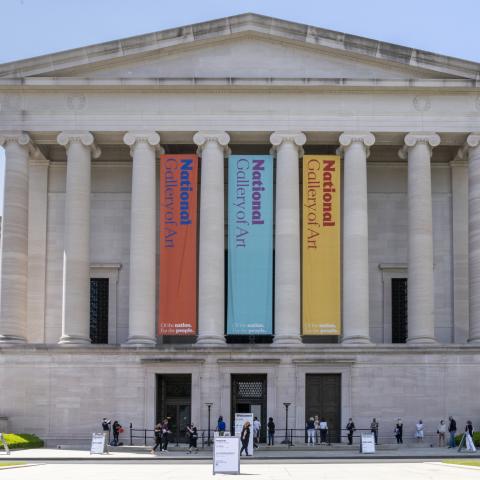The Entombment
c. 1507/1513
Sculptor, Paduan, 1470 - 1532

In the north Italian city of Padua, a major center of Renaissance bronze production, Riccio stood out as the most brilliant master. The Entombment of Christ is a recurring subject in his reliefs. This is his largest single relief and his masterpiece on the theme.
Riccio modeled his crowd of mourners in such high relief that many emerge almost as separate statuettes. To an astonishing degree, space penetrates the crowd and the landscape, flowing behind the freestanding trees. People of all ages join in the funeral procession, their faces and costumes rendered with strength and precision. Their expressions range from stoic sorrow to wild outbursts, with streaming hair, gesticulating arms, and mouths open in howls. These frantic attitudes had precedents in the art of antiquity and in the works of Donatello and his pupil Bellano that Riccio could see in Padua. The scene also recalls the funeral of the mythological hero Meleager, depicted on many Roman sarcophagi and recommended to artists by the theorist Alberti as a convincing portrayal of a dead man weighing down his bearers.
The man just in front of Christ's feet carries an urn inscribed AERDNA, "Andrea" spelled backwards. The presence of this barely disguised signature has led to speculation that the artist intended this relief to mark his own tomb.

West Building Ground Floor, Gallery G14
Artwork overview
-
Medium
bronze
-
Credit Line
-
Dimensions
overall: 50.4 x 75.5 cm (19 13/16 x 29 3/4 in.)
gross weight: 53180 gr (117.241 lb.) -
Accession
1957.14.11
Artwork history & notes
Provenance
Vicomte Isidore-Hippolyte de Janzé [1790–1865], Paris; (his estate sale, Hôtel Drouot, Paris, 16 April 1866, no. 38); (Couvreur);[1] Louis-Charles Timbal [1821–1880], Paris; sold 29 November 1872 with his collection to Gustave Dreyfus [1837–1914], Paris; his estate; purchased 1930 with the entire Dreyfus collection by (Duveen Brothers, Inc., London, New York, and Paris); sold 1944 to the Samuel H. Kress Collection, New York; gift 1957 to NGA.
[1] The Janzé sale information was kindly provided by Marie-Amélie Carlier, e-mail of 12 October 2007 to Nicholas Penny, in NGA curatorial files.
Associated Names
Exhibition History
1874
Objets d'Art, Exposés au profit de la Colonisation de l'Algèrie par les Alsaciens-Lorrains, Palais de la Prèsidence du Corps Lègislatif, Paris, 1874, no. 35 of Salon 13.
1878
Exposition Universelle: La Sculpture au Trocadero, Paris, 1878.
1932
The Dreyfus Collection, Fogg Art Museum, Cambridge, Massachusetts, 1932.
2008
Andrea Riccio: Renaissance Master of Bronze, The Frick Collection, New York, 2008-2009, no. 27, repro.
Rinascimento e Passione per L'Antico. Andrea Riccio e il suo tempo, Museo Castello del Buonconsiglio, Trento, 2008, no. 19, repro.
Bibliography
1907
Vitry, Paul. "La collection de M. Gustave Dreyfus: I. - La Sculpture." Les Arts 72 (December 1907): 4.
1949
Seymour, Charles. Masterpieces of Sculpture from the National Gallery of Art. Washington and New York, 1949: 180-181, note 42, repro. 130-132.
1965
Summary Catalogue of European Paintings and Sculpture. National Gallery of Art, Washington, 1965: 166.
Pope-Hennessy, John W. Renaissance Bronzes from the Samuel H. Kress Collection: Reliefs, Plaquettes, Statuettes, Utensils and Mortars. London, 1965: no. 203.
1968
National Gallery of Art. European Paintings and Sculpture, Illustrations. Washington, 1968: 145, repro.
1983
Wilson, Carolyn C. Renaissance Small Bronze Sculpture and Associated Decorative Arts at the National Gallery of Art. Washington, 1983: 86.
1984
Walker, John. National Gallery of Art, Washington. Rev. ed. New York, 1984: 632, no. 985, repro.
1989
Pope-Hennessy, John. "The Study of Italian Plaquettes." Studies in the History of Art 22 (1989): 19-20, fig. 3.
Sturman, Shelley and Berrie, Barbara. "Technical Examination of Riccio Plaquettes." Studies in the History of Art 22 (1989):176-177, 186, repro.
1992
National Gallery of Art, Washington. National Gallery of Art, Washington, 1992: 293 (repro. is wrong object [1957.14.252]; repro. corrected in 1995 rev. ed.).
1994
Sculpture: An Illustrated Catalogue. National Gallery of Art, Washington, 1994: 190, repro.
2000
National Gallery of Art Special Issue. Connaissance des Arts. Paris, 2000:61.
2008
Warren, Jeremy. "Review: Antico; Riccio. Mantua and Trento." The Burlington Magazine 150:1268 (November 2008): 786.
2009
Penny, Nicholas. "Andrea Riccio. New York [exhibition review]." The Burlington Magazine 151 (January 2009): 64.
Gasparotto, Davide, and Luciana Giacomelli. "L'altare Maffei in Sant'Eufemia a Verona, Giulio della Torre e Andrea Riccio." Nuovi studi 14 (2009): 119-120, 124-125 nn. 29-36, fig. 154.
2010
Draper, James David. "Review of exhibitions 'Rinascimento e passion per l’antico: Andrea Riccio e il suo tempo,' and 'Andrea Riccio: Renaissance Master of Bronze.'” _The Sculpture Journal_19.1 (2010): 129-133, esp. 131.
2015
Smith, Dylan T. "Riccio in Relief: Documented Sculpture as a Technical Context for 'The Entombment'." Facture: conservation, science, art history 2 (2015): 18-53, repros. 19, 20, 23, 25, 26, 42, figs. 1-7, 22a.
2020
Malgouyres, Philippe. De Filarete à Riccio. Bronzes italiens de la Renaissance (1430-1550). La collection du musée du Louvre. Paris, 2020: 36, 149, 152, 183, 187.
Bormand, Marc, Beatrice Paolozzi Strozzi and Francesca Tasso, eds. _Le Corps et l’Âme. De Donatello à Michel-Ange. Sculptures italiennes de la Renaissance. Exh. cat, Paris, 2020: 260-263, cat. 75a (entry by Philippe Malgouyres; work was not exhibited in either Paris or Milan).
Inscriptions
center right on center band of amphora, carried by mourner preceding Christ's body: AERDNA (retrograde inscription of artist's Christian name, ANDREA)
Markings
None on bronze, though reverse surface is plastered over large areas to stabilize attachments; walnut frame (evidently made in 1850s/1860s for either Vicomte de Janzé or Louis-Charles Timbal, in Paris), later stamped (in English) MADE IN FRANCE; frame also bears three circular paper labels stamped DOUANES FRANÇAISES (French Customs) and inscribed with penciled numbers (at the moment of Duveen Brothers' export of the object, c. 1930).
Wikidata ID
Q63809193


